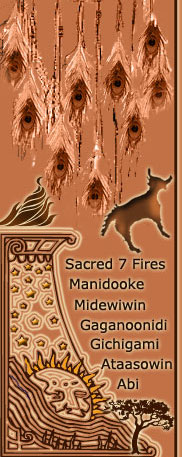Lake Superior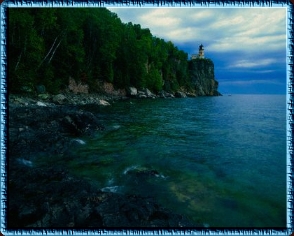 Lake Superior or Gitchigumi (meaning Great Water or Great Lake) is the largest lake in the world, containing an eighth of the world's fresh water. At its deepest point, it measures 1,333 fee in depth, with an average water temperature of 34 degrees F. Around two hundred rivers and thousands of streams feed into it, but the grand waters only have one outlet - Saint Mary's River (home of my ancestors) which connects it to Lake Huron. It extends 350 miles in length and up to 160 miles in width. Lake Superior rests in a cradle of ancient Precambrian rock on the southern tip of the Canadian Shield. The shores of this amazing lake are rich, rugged, aesthetic and mesmerizing. Craggy cliffs abound, towering over pebbled water edges - often agates are found in the pebbles, especially along the northern shore of the lake. The water is so crystal clear that the pebbles can be seen from great depths. In some areas, the water becomes deep just a few feet from shore. It is one of the most beautiful rugged landscapes on this blessed planet. The shores are often shrouded in thick layers of fog, called dragon breaths. To visit and take time to meditate at her shores is indeed a special gift. Very few can resist the mysterious palpable energy that radiates there. It demands your respect and your awareness. The Anishanabe knew the presence and majesty of this great lake, they 'heard" the stories of the rocks and crags, the shores and deep waters. They believed that everything had a story or adizokan - the rocks, the water, the animals, and the people. Rocks are ancient, thus their story is long and it is large in its historic spread. We can learn much from the natural surroundings of Lake Superior - in some parts there are no signs of civilization - it is like returning to the beginning of time, at least, the beginning of Canadian and US chronology. Michi Peshu The Anishinabe tell of the great underwater lynx like creature who lives in the depths of Gitchigumi - the creature called Mishi Peshu or Mishipashoo. He is the ulitmate metaphor representing the power, mystery and innate danger that comes from these sacred waters. With razor like spikes on his back, the face of a lynx or panther, and the body of a sea serpent, this creature demanded respect. The Anishinabe offered tobacco and prayer to the creature spirit before they embarked out onto the waters in their canoes. The calm waters of Lake Superior can be quickly transformed into raging squalls and huge waves from the northern, north-eastern, and north-western gales that often suddenly crop up. These gales sweep over the open water, quickly picking up momentum and causing huge waves, some up to 40 feet high. The Anishinabe tell of the great underwater lynx like creature who lives in the depths of Gitchigumi - the creature called Mishi Peshu or Mishipashoo. He is the ulitmate metaphor representing the power, mystery and innate danger that comes from these sacred waters. With razor like spikes on his back, the face of a lynx or panther, and the body of a sea serpent, this creature demanded respect. The Anishinabe offered tobacco and prayer to the creature spirit before they embarked out onto the waters in their canoes. The calm waters of Lake Superior can be quickly transformed into raging squalls and huge waves from the northern, north-eastern, and north-western gales that often suddenly crop up. These gales sweep over the open water, quickly picking up momentum and causing huge waves, some up to 40 feet high.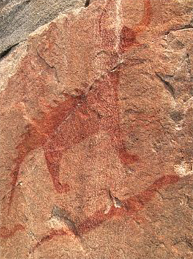 Pictographs of Mishi Peshu can be found in several areas around the Great Lakes. The one in the picture to the right is found at Agawa Bay, Lake Superior National Park, in northern Ontario, north of Sault Ste. Marie. The Midewiwin Society claimed in 1850 that this pictograph was painted by an Anishinabe shaman, and represents a heroic 4 day crossing of Lake Superior by a war party of five canoes. The author is believed to be a tribal shaman named Myeengun which means "Wolf."
The images are painted using red ochre, a pigment made from the iron ore called hematite, mixed with clay minerals. This is the most famous rock art painting in Canada, according to National Collection Archive sources. Pictographs of Mishi Peshu can be found in several areas around the Great Lakes. The one in the picture to the right is found at Agawa Bay, Lake Superior National Park, in northern Ontario, north of Sault Ste. Marie. The Midewiwin Society claimed in 1850 that this pictograph was painted by an Anishinabe shaman, and represents a heroic 4 day crossing of Lake Superior by a war party of five canoes. The author is believed to be a tribal shaman named Myeengun which means "Wolf."
The images are painted using red ochre, a pigment made from the iron ore called hematite, mixed with clay minerals. This is the most famous rock art painting in Canada, according to National Collection Archive sources. Legend of the Sleeping Giant On an island just outside Thunder Bay, now known as "Isle Royale", there lived a great tribe of Ojibwe Natives. Because of their loyalty to the Great Spirit, and their peaceful and industrious mode of living, Nanabijou, the Spirit of the Deep Sea Water, decided to reward them. One day he called their Chief to his great Thunder Temple on the mountain and warned him that if he told the secret to the white man, that he, Nanabijou would be turned to stone. The Chief gave his promise, and Nanabijou told him of the rich silver mine, now known as "Silver Islet". The Great Spirit told him to go to the highest point on Thunder Cape, and here he would find the entrance to a tunnel that would lead him to the centre of the mine. On an island just outside Thunder Bay, now known as "Isle Royale", there lived a great tribe of Ojibwe Natives. Because of their loyalty to the Great Spirit, and their peaceful and industrious mode of living, Nanabijou, the Spirit of the Deep Sea Water, decided to reward them. One day he called their Chief to his great Thunder Temple on the mountain and warned him that if he told the secret to the white man, that he, Nanabijou would be turned to stone. The Chief gave his promise, and Nanabijou told him of the rich silver mine, now known as "Silver Islet". The Great Spirit told him to go to the highest point on Thunder Cape, and here he would find the entrance to a tunnel that would lead him to the centre of the mine.
Apparently the Chief and his people found the mine, for the Ojibwe became famous for their beautiful silver ornaments. So beautiful indeed were they, that the Sioux warriors on seeing them upon their wounded enemies, strove to wrest their secret from them. However, torture and even death failed to make the gallant Ojibwe divulge their secret and the Sioux chieftains had to devise another scheme to find the source of the Ojibwe silver. One day they summoned their most cunning scout to a pow-wow and a plan was formed. The scout was to enter the Ojibwe camp disguised as one of them. This he did and in a few days succeeded in learning the secret of the island of silver. Going to the mine at night he took several large pieces of the precious metal in order to prove to his chieftain that he had fulfilled his mission. The scout however never returned to his camp, for on his way back he stopped at a white traders post to purchase some food. Having no furs or money with which to pay for the goods, he used a piece of the silver. Seeing such a large piece of the gleaming metal, two white men sought to obtain the whereabouts of its source, in order to make themselves fabulously rich. After filling the Sioux scout with alcohol they persuaded him to show them the to the mine. When almost in sight of "Silver Islet" a terrific storm broke over the Cape. The white men were drowned and the Sioux man was found in a crazed condition floating aimlessly in his canoe, but the most extraordinary thing that had happened during the storm, was that where once was a wide opening to the bay, now lay what appeared to be a great sleeping figure of a man. The Great Spirit's warning had been fulfilled and he had been turned to stone. On a little island at the foot of the Sleeping Giant, can still be seen the partly submerged shafts of what was once the richest silver mine in the northwest. 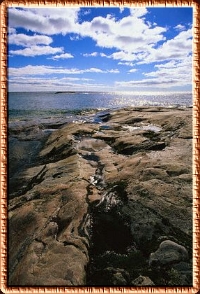
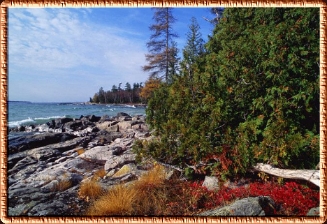
Resources
|
 |
|||||||
© Chi-Manidoo.com 2005 - 2008 June Kaminski All rights reserved.
Visions of Adonai Design

